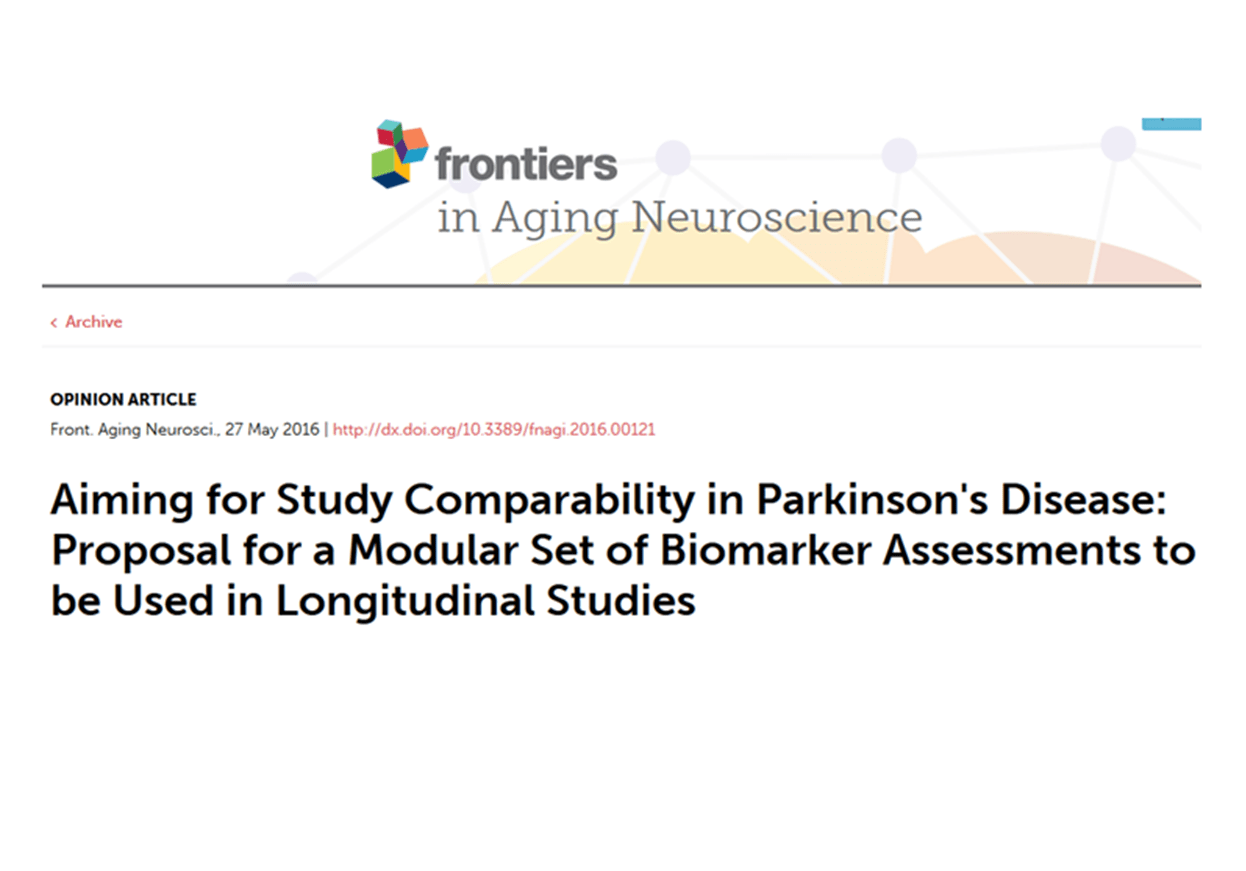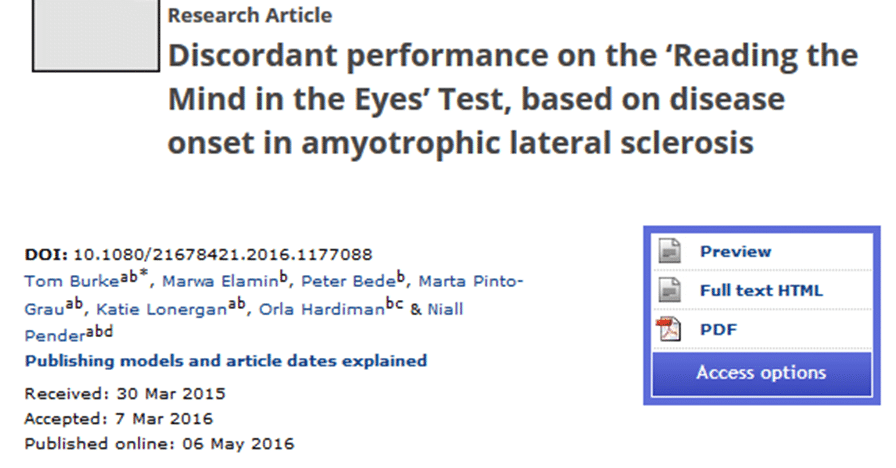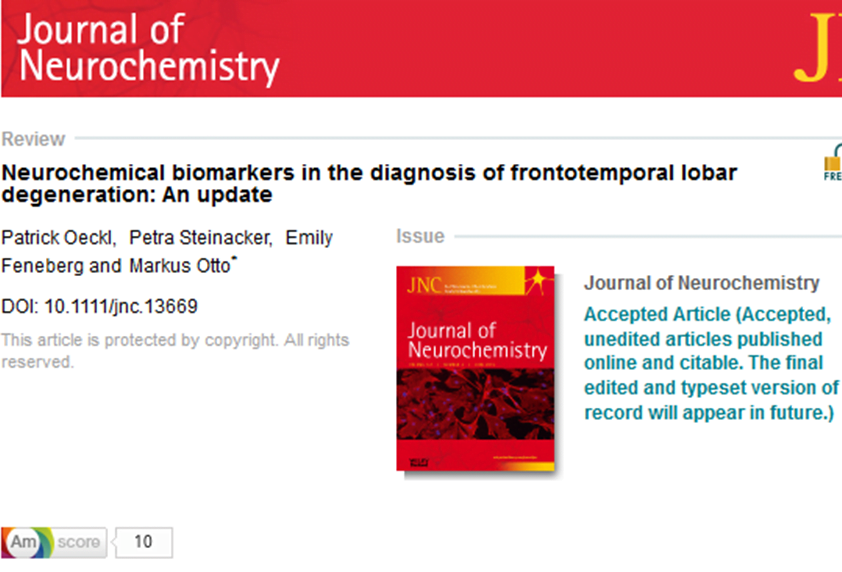 “Aiming for Study Comparability in Parkinson’s Disease: Proposal for a Modular Set of Biomarker Assessments to be Used in Longitudinal Studies” has been published in Frontiers in Aging Neuroscience. This research was supported by JPND through the BioLoC-PD working group, selected under the 2014 call for working groups to inform cohort studies in neurodegenerative disease research.
“Aiming for Study Comparability in Parkinson’s Disease: Proposal for a Modular Set of Biomarker Assessments to be Used in Longitudinal Studies” has been published in Frontiers in Aging Neuroscience. This research was supported by JPND through the BioLoC-PD working group, selected under the 2014 call for working groups to inform cohort studies in neurodegenerative disease research.
Tag Archives: Biomarkers
“ Discordant performance on the ‘Reading the Mind in the Eyes’ Test, based on disease onset in amyotrophic lateral sclerosis” has been published in Amyotrophic Lateral Sclerosis and Frontotemporal Degeneration. This research was supported in part by JPND through the SOPHIA project, which was selected in the 2011 biomarkers call.
Discordant performance on the ‘Reading the Mind in the Eyes’ Test, based on disease onset in amyotrophic lateral sclerosis” has been published in Amyotrophic Lateral Sclerosis and Frontotemporal Degeneration. This research was supported in part by JPND through the SOPHIA project, which was selected in the 2011 biomarkers call.
 “CSF Aβ1–42 – an excellent but complicated Alzheimer’s biomarker – a route to standardisation” has been published in Clinica Chimica Acta. This research was supported in part by JPND through the BIOMARKAPD project, selected in the 2011 biomarkers call.
“CSF Aβ1–42 – an excellent but complicated Alzheimer’s biomarker – a route to standardisation” has been published in Clinica Chimica Acta. This research was supported in part by JPND through the BIOMARKAPD project, selected in the 2011 biomarkers call.
 “Neurochemical biomarkers in the diagnosis of frontotemporal lobar degeneration: An update” has been published in the Journal of Neurochemistry. This research was supported in part by JPND through the SOPHIA and BiomarkAPD projects, selected in the 2011 biomarkers call, and the PreFrontALS project, selected in the 2013 preventive strategies call.
“Neurochemical biomarkers in the diagnosis of frontotemporal lobar degeneration: An update” has been published in the Journal of Neurochemistry. This research was supported in part by JPND through the SOPHIA and BiomarkAPD projects, selected in the 2011 biomarkers call, and the PreFrontALS project, selected in the 2013 preventive strategies call.
“The segmental diffusivity profile of amyotrophic lateral sclerosis associated white matter degeneration“ has been published in the European Journal of Neurology. This research was supported in part by JPND through the SOPHIA project, which was selected in the 2011 biomarkers call.
A paper titled “The selective anatomical vulnerability of ALS: ‘disease-defining’ and ‘disease-defying’ brain regions” has been published in Amyotrophic Lateral Sclerosis and Frontotemporal Degeneration. The research group of Orla Hardiman received support from JPND through the SOPHIA project, which was selected for support in the 2011 biomarkers call.
A new paper titled “Identification of new molecular alterations in Fatal Familial Insomnia” has been published in Human Molecular Genetics. It was in part funded by JPND through the DEMTEST project, which was selected for support in the 2011 biomarkers call.
The Innovative Medicines Initiative 2 (IMI 2) indicative topic text for Call 5 is now available, with heavy emphasis on Alzheimer’s Disease. The following topics are under consideration for inclusion in the call:
- Patient perspective elicitation on benefits and risks of medicinal products from development through the entire life cycle, for integration into benefit risk assessments by regulators and health technology assessment bodies
- Diabetic kidney disease biomarkers (DKD-BM)
- Inflammation and Alzheimer’s disease (AD): modulating microglia function – focussing on TREM2 and CD33
- Understanding the role of amyloid biomarkers in the current and future diagnosis and management of patients across the spectrum of cognitive impairment (from pre-dementia to dementia)
- Evolving models of patient engagement and access for earlier identification of Alzheimer’s disease: phased expansion study
- Apolipoprotein E (ApoE) biology to validated Alzheimer’s disease targets
Note: All information regarding future IMI Call topics is indicative and subject to change. Final information about future IMI Calls will be communicated after approval by the IMI Governing Board.
With several therapeutic approaches in development for Huntington’s disease, there is a need for easily accessible biomarkers to monitor disease progression and therapy response.
Researchers at Leiden University Medical Center in The Netherlands have discovered a panel of five genes whose expression in whole blood correlates with progression of Huntington’s disease.
In a study published in The European Journal of Human Genetics, the group reported that transcriptome analysis of 91 Huntington’s mutation carriers, about one third of whom were presymptomatic, and 33 controls yielded 167 differentially expressed genes. Twelve of the top 20 genes were validated using a different technique, and five of these proved significant in a smaller, independent cohort as well.
The authors suggest a first empiric formula predicting total motor score from the expression levels of our biomarker panel. Their data supports the view that peripheral blood is a useful source to identify biomarkers for Huntington’s disease and monitor disease progression in future clinical trials.
